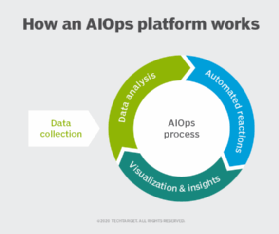Using AIOps for cybersecurity and better threat response (Techtargets.com)
AIOps platforms, when properly tuned, can benefit all of IT in important ways. Learn how these advanced security tools improve threat detection and response in myriad ways.
There’s a bit of confusion regarding which departments within IT could benefit from an AI for IT operations (AIOps) platform. The answer is: all of them. While network operators might be most excited about using an AIOps platform to find network performance issues, other IT teams should be just as excited. Security teams, for example, can benefit from using AIOps for cybersecurity. The platform enables them to gain a significant amount of data security visibility and intelligence. These tools can accomplish a variety of essential tasks, from observation to engagement to acting on threats.
There are several ways security teams can use AIOps to detect threats, and there are steps they must take to tune an AIOps platform in order to quickly identify and resolve issues.
How using AIOps benefits cybersecurity
Speed is of the essence when it comes to security. One way to be a step ahead of cybercriminals is to know, from a network device perspective, the who, what, when and where. AIOps platforms use collected streaming network telemetry data to auto-discover, inventory and classify devices. Not only can most AIOps platforms inventory network infrastructure components, but they can also assess all wired, wireless and IoT devices communicating on the corporate network or in the cloud.
Beyond the benefit of network and device visibility, AIOps can use device classifications to verify that business-critical devices are connecting to the appropriate virtual LAN or wireless service set identifier. Network segmentation is a critical part of edge security. Thus, having a tool that can help quickly spot these types of problems is highly desired.
Collected deep packet inspection and other telemetry data can also be used to plot device communication behavior over time.
When device communication becomes abnormal and that behavior exceeds an AI-defined threshold, an alert is triggered to a security administrator to investigate the potential compromise.
Some AIOps platforms include threat intelligence analysis services that update the customer on any new or emerging threats. Additionally, most will integrate with other security tools, including network firewalls, SIEM and security orchestration, automation and response. These external security tools and services, combined with AIOps traffic behavioral analysis, can be on the lookout for a host of security threats. What’s more, using AIOps for cybersecurity means data will be analyzed to the point where the exact threat can be identified with steps to contain or remediate the issue.
How security admins should use AIOps
Automated processes within AI will go a long way, but the use of AIOps platforms for security purposes needs human involvement. For example, fine-tuning the tool beyond the default automated discovery will help better categorize network components for behavior analysis. Additionally, the AI within AIOps will need to be told which apps, services and other resources are considered business critical. Identifying important data flows ensures the AIOps platform will better understand what security events are deemed more critical than others.

When an alert is triggered, AIOps can provide detailed information regarding the type of threat, its effects and what can be done to remediate it. Administrators will be required to respond to an alert, investigate it and attempt the suggested remediation steps. In some cases, AIOps can be set up to automate a response. However, it’s more likely that the administrator will be required to intervene. Additionally, if the suggested remediation steps fail, the admin will likely have to rely on other means to perform true root cause analysis and eliminate the threat on their own. Thus, it’s important to note that, while AIOps can help automate some IT security tasks, we’re still a long way from no longer having to employ or contract the appropriate level of personnel.
Sharing the wealth
Historically speaking, security teams shared little information regarding technical threats with other parts of IT until the last moment. The use of security tools and dashboards has traditionally been limited to a small group to administrate, keeping all other IT operations staff in the dark. In some cases, it is necessary to keep sensitive security information and data as protected as possible. But in many other cases, it would be useful for network, server and application teams — and even other department leaders — to be aware of an ongoing threat. The reason is that the threat may be affecting the performance of the application or service under attack, meaning these teams will waste time troubleshooting a performance problem that already has a known root cause.
If your organization is using AIOps for cybersecurity, remember that opening an AIOPs platform to all teams to use how they see fit also opens an opportunity for improved inter-departmental communication. From a security perspective, customized dashboards can be built that offer non-security teams a glimpse into ongoing threats. These dashboards can provide the right level of communication without compromising or leaking sensitive information.

